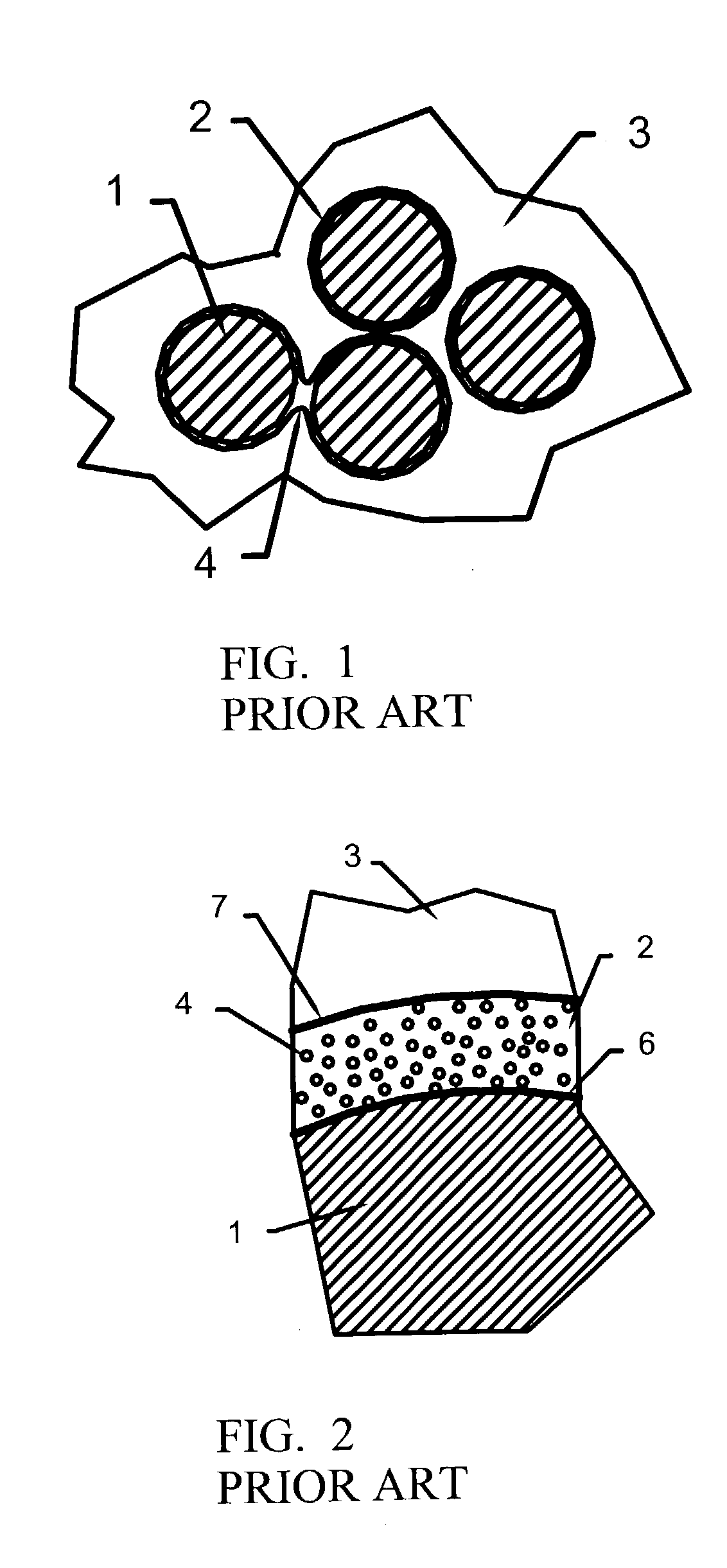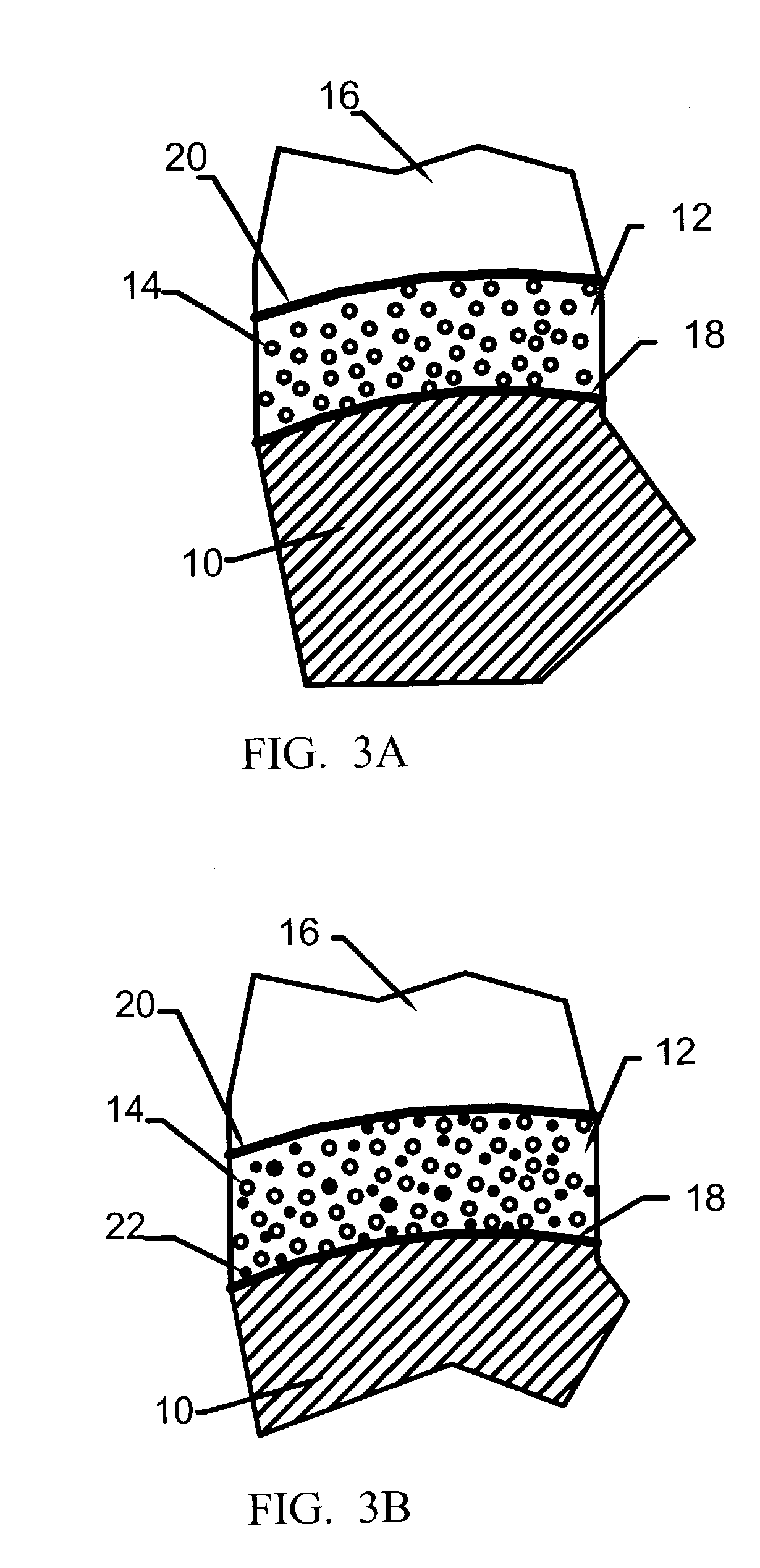Ceramic forming polymer derived ceramic composite and methods
a ceramic composite and ceramic forming technology, applied in the field of ceramic composites, can solve the problems of complex and expensive cvd process, reduced application efficiency, and reduced strength of the coating itself, so as to reduce the cost of application, resist oxidation, and reduce the effect of cos
- Summary
- Abstract
- Description
- Claims
- Application Information
AI Technical Summary
Benefits of technology
Problems solved by technology
Method used
Image
Examples
example 1
Coating Polyacronitrile-based Carbon Fibers
[0049] A 50 gram polyacronitrile (PAN) based carbon fiber disk preform is heat treated by heating in inert gas to 1600.degree. C.-1800.degree. C. for 2 hours. An amount of oxycarbide such as Starfire System's silicon oxycarbide (SOC) 35A (FIG. 6) may be used for the ceramic coating. As an alternative, other silicon oxycarbide such as those shown in FIGS. 4 and 5 may be used. In any case, an amount of polymer roughly equal to 18%-22% of the mass of the preform is weighed out on, for example, a three-place analytical balance. An amount of ethyl alcohol, or toluene roughly equal to 150% to 200% of the mass of the preform is weighed out. The polymer is dissolved in the solvent by, for example, stirring in a beaker or flask using a magnetic driven stirrer driving a polytetrafluoroethylene (PTFE) coated stir bar. The polymer is slowly added to the solvent while stirring until all is added. The solution is stirred until all the polymer is dissolve...
example 2
Coating Near-stoichiometric Silicon Carbide Fibers
[0050] A square foot of cloth composed of near-stoichiometric silicon carbide fiber such as Sylramic, or Tyranno SA, or Hi-Nicalon type-S is first desized (the organic coating needed to allow weaving the fibers) by heating to 450-600.degree. C. in air or to 800.degree. C. in inert gas. An amount of oxycarbide forming polymer such as Starfire System's SOC 500L (FIG. 5), SOC 500B (FIG. 4) or carbon rich polycarbosilane ceramic forming polymer roughly equal to 8-11% of the mass of the cloth is weighed out on a three-place analytical balance. An amount of hexane, or tetrahydrofuran approximately equal to 100%-150% of the mass of the cloth is weighed out. The polymer is dissolved in the solvent by stirring in a beaker or flask using a magnetic driven stirrer driving a PTFE-coated stir bar. The polymer is slowly added to the solvent while stirring until all is added. The solution is stirred until all the polymer is dissolved and the soluti...
example 3
Coating Silicon Oxycarbide (Si--C--O) Or Carbon-rich Silicon Carbide Fibers
[0051] A 50 gram woven preform composed of Hi-Nicalon, Ceramic Grade Nicalon, Tyranno LOX-M, Tyranno LOX-E or ZMI fiber is first desized by heating to 450-600.degree. C. in air or to 800.degree. C. in inert gas. An amount of SOC such as the polymers in FIG. 4 or 5 roughly equal to 8-25% of the mass of the preform is weighed out on a three-place analytical balance. An amount of toluene solvent roughly equal to 75%-150% of the mass of the preform is weighed out. The polymer is dissolved in the solvent by stirring in a beaker or flask using a magnetic driven stirrer driving a PTFE-coated stir bar. The polymer is slowly added to the solvent while stirring until all is added. The solution is stirred until all the polymer is dissolved and the solution becomes clear, e.g., approximately 15 minutes to 1 hour. The preform is placed in an aluminum foil boat and the polymer solution is then poured over the preform. The ...
PUM
| Property | Measurement | Unit |
|---|---|---|
| Time | aaaaa | aaaaa |
| Time | aaaaa | aaaaa |
| Percent by mass | aaaaa | aaaaa |
Abstract
Description
Claims
Application Information
 Login to View More
Login to View More - R&D
- Intellectual Property
- Life Sciences
- Materials
- Tech Scout
- Unparalleled Data Quality
- Higher Quality Content
- 60% Fewer Hallucinations
Browse by: Latest US Patents, China's latest patents, Technical Efficacy Thesaurus, Application Domain, Technology Topic, Popular Technical Reports.
© 2025 PatSnap. All rights reserved.Legal|Privacy policy|Modern Slavery Act Transparency Statement|Sitemap|About US| Contact US: help@patsnap.com



